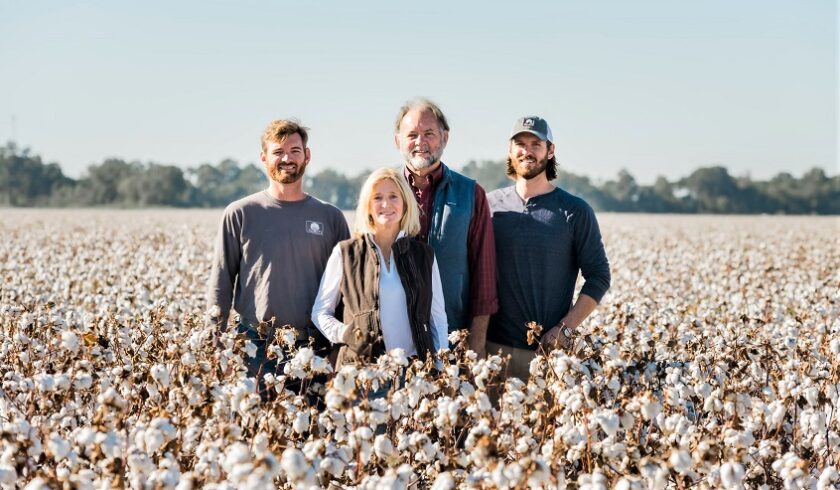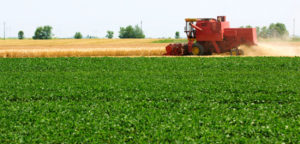
Almost 40 years ago, Jay Hardwick traded a life in academia for what has turned out to be a fruitful career in farming. Today he grows mainly cotton, corn and soybeans on his family’s 12,000-acre operation in Tensas Parish, North East Louisiana.
His dedication to the land is exemplary and has earned him a clutch of awards, but now he’s starting to hand over the reins to sons Mead and Marshall – the fifth generation.
USSA spoke to them about the challenges of running a business while respecting nature, and the practices that are enabling them to get the balance right.
Hardwick Planting Co. is evidently a family affair. Can you tell me more about its history?
We’re a family-owned farming operation. Farming has been in our family for almost a hundred years. The main farm goes back even further and has been in agricultural production since the early 1800s, when it was operated by the previous owners.
Today, myself, my two sons and my nephew Wilson are the only members of the family who farm the land, but my wife Mary and the wider family are also involved as the landowners. They are the stakeholders we are accountable to.
How important is it to you to be able to continue such a long-established family tradition?
 Very important. For me, sustainability includes the sustainability of the family farm, ownership and operations and handing it down to my sons – the fifth generation. This means balancing the needs of production agriculture and the needs of the surrounding environment to ensure that future generations have a fully functioning farm.
Very important. For me, sustainability includes the sustainability of the family farm, ownership and operations and handing it down to my sons – the fifth generation. This means balancing the needs of production agriculture and the needs of the surrounding environment to ensure that future generations have a fully functioning farm.
So, Jay, what got you into farming in the first place? And what made you stay?
I was an academic, working as head of art at Southern Methodist University in Dallas, Texas. However, when my wife Mary and I were about to have our first child (Mead) we decided to return to Tensas Parish and the family farm to be closer to Mary’s parents. The lure of landscape has kept us here. There’s something very seductive and intriguing about planting things and watching them grow. I had no idea that it would become my passion. Also, the realization that my wife Mary had a latent ambition to return to where she grew up really motivated me to want to become part of the family farm.
Mead and Marshall, how long have you been working on the farm and what’s your background?
[Marshall] We grew up on the farm and worked here during our weekends and summer holidays. I went off to [Louisiana State] University, graduated with a Bachelor’s degree in Agriculture Economics and a Masters in Plant Environmental Science, returning to the family farm to work here full-time in 2013.
[Mead] After high school, I went to Southern Methodist University in Dallas, Texas and graduated with a Bachelor of Business Administration with a major in finance. I initially took a job in real estate finance, got married and had two children before returning here with my wife and two sons in 2014. Swapping the city and our high-pressure jobs for a more relaxed pace of life simply made sense for our family.
Jay, what roles do each of you play on the farm?
As we transition, I’m gradually taking on fewer duties, focusing mainly on marketing our crops, while Mead and Marshall are taking on more responsibility.
Given their qualifications and skills, Mead is responsible for finance and the operational side of the business, while Marshall is more focused on the agriculture side. He’ll decide what crops we grow, where they go in the field and how many acres we devote to them.
That said, there is a lot of crossover and we’re all very hands-on. At specific times of the year such as planting or harvest, when there’s more work than our six employees can handle, the three of us will get involved.
“We’re not doing sustainability because it’s “cool”, we’re doing it because it’s the right thing to do and it’s best for our business. You just have to look at our performance over the past 25 to 30 years to see that our conservation practices are having a positive impact.”
Mead Hardwick
Mead, what are some of the practices and technologies you use on the farm and why?
Often, we’ll use new practices and innovations to solve a problem. In this part of the world we get up to 60 inches of rain a year which leaves the (fine clay soil) beds we plant our crops on susceptible to erosion. Using cover crops helps us maintain the beds’ integrity and provide a solid structure we can plant into.
We use a lot of precision agriculture, mainly to increase efficiencies. We have little control over the market price for our crops so are always looking for ways to be more cost-efficient. The latest variable rate technologies mean we use less input resources like nutrients and fertilizer because we can pinpoint where on the field they’re needed. We soil sample around a third of our land every year and use the data to guide where we apply fertilizer. This saves money and time. It also makes us more profitable and, because we’re using less chemicals, more sustainable.
[Marshall] The ability to gather data and improve is constant. We’re not in control of what new technologies come out but when they’re available and safe, we’ll try them. We’ve been gathering lots of data for several years so our next step will be to look at how we use that data to make even better decisions.
Jay, you’ve talked before about respecting the natural habitat. Why is that so important?
Soil scientist and conservationist Aldo Leopold once said that the less aggressive agriculture can be, the more natural capacity there is for nature to revive itself. That told me that less is best. The challenge is meeting the demands of raising a crop and generating revenue while respecting the surrounding landscape for future generations.
We have 20,000 acres of land in total (including 12,000 acres that are farmed) and 40 per cent of that is wildlife habitat. We have riparian areas, managed forest timberland and a very active and growing population of black bears, deer and other species, all of which provides a rich source of natural diversity to our farming operation. It’s a symbiotic relationship and it helps build a healthy environment for agricultural production.
Soil health is also important. Using cover crops or even native vegetation provides a natural, low cost way to get water into the ground and stop it running off. Keeping organic matter on the surface provides a whole world of microorganisms underneath the ground that are beneficial to plants, which helps to stabilize and improve yields without using crop protection products. This is what sustainable, regenerative agriculture is all about.
Jay, what’s next for the farm?
Mead and Marshall are on the edge of making some profound changes that amplify sustainable farming – both economically and environmentally – and go beyond what I, my father-in-law and his father before him achieved. I think biology is going to be a great driving force in their future. It’s such a thrill to watch and be part of it.


